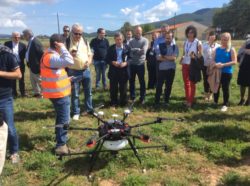Less than 1% of Italian farmers use technologies enabling precision agriculture. Indeed, there are things that only humans can do: technologies can simply not replace the work of the « butteri » (Italian cowboys), for example, that keep an eye on over 500 Maremma cows daily. However, when it comes to monitoring, modelling and forecasting there are integrated applications that can support farmers in their tasks.
Earth Observation, Big Data, IoT, Robotics, and Photonics are being increasingly used by the agriculture sector. Their synergic use allows the shift to the new paradigm of Sustainable Precision Agriculture whilst enabling at the same time the development of the digital economy in Agriculture. The need for change towards this new paradigm is well acknowledged at EU level, as various papers and reports from EU Institutions provide good analysis and suggestions in this sense.

Watify, an awareness-raising campaign funded by the European Commission to stimulate the technological transformation of Europe’s industry, organized two matchmaking events in Tuscany on the topics of Photonics for agriculture (Florence, May 16th) and Precision Farming technologies (Alberese, Grosseto May 17th).
NEREUS was invited to ensure that the opportunities and challenges offered by space technologies were duly showcased in the discussions. In the past years, many members of NEREUS have expressed interest in the Agriculture field. The series of activities developed under this strand are rooted in the collection of 26 regional use cases showcasing “How can Space make the difference for the Agriculture sector” resulting from the research activities of the EO/Copernicus Working Group chaired by Prof. Valerio Tramutoli (University of Basilicata) and Dr. Branka Cuca (Politecnico di Milano). It has been pursued workshops, working papers and projects.
- How can Space make a difference for the Agriculture Sector? The diversity and cost-effectiveness of technological solutions to monitor agricultural systems and their surrounding environment are increasing rapidly. The EO/Copernicus Working Group, co-chaired by Prof. Valerio Tramutoli (University of Basilicata) and Dr. Branka Cuca (Politecnico di Milano), published an informative study illustrating concrete examples and effective solutions based on space technologies that are already in place across European Regions in the domain of Agriculture and Rural Development.
- When Space Meets Agriculture | Fostering interregional collaborations, investments, and definition of user requirements NEREUS and Consorzio TeRN, with the patronage of Basilicata Region, and with the support of COPA COGECA and the ERIAFF Network, organized a two-day workshop focused on the importance and potential of Europe’s space systems, Copernicus and EGNOS/Galileo to overcome the current and future challenges in the agricultural sector. The workshop got a strong response and brought together almost 150 participants from different sectors and countries, amongst which numerous representatives of public administrations.
Tuscany Region, one of the regions leading the reflection on sustainable precision agriculture, we have been facilitating the dialogue between the technology providers and specific professional user communities, in this case the farmers, paying particular attention in understanding the role of regions in this interplay. Doing so in Tenuta dell’Alberese, a 100% public demofarm of Tuscany Region inserted in a European network, invites us all to take the role of public authorities seriously: in their mission to enable, connect, and mediate.

